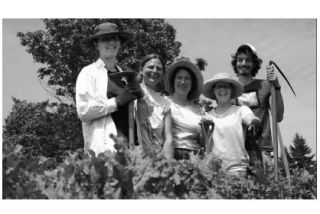climate matters
Shoulder-To-Shoulder Farm, one of Vashon’s hidden treasures, spreads out behind Vashon Cohousing on land leased from the Roseballen Community Land Trust.
The Collective’s founding farmer, Dana Schuerholz, and co-manager Margaret Hoeffel, have many years of experience as organic growers. They have farmed individually and, with others, have been Community Supported Agriculture (CSA) managers and have taught classes to novice wanna-be gardeners, such as myself. For a time, Margaret ran Blue Moon Farm on the same site as the S-to-S Collective Farm, and Dana operates the Homestead Farming Wilderness School a stone’s throw away.
In a spark of brilliance, they fashioned the idea of pulling together a group of committed folks who wanted to work a piece of land together, sharing the resources, responsibilities and joys of growing their own food. With 10 members (both families and individual), they are in the midst of their second growing season. In exchange for sharing costs and working at least six hours per week on this intensively farmed acreage, they are entitled to reap what they sow. Because the goal is self-sufficiency and not financial profit, they grow what they want to eat and what’s possible year-round, rather than what might sell at the farmers market.
Sitting cross-legged under a shade tree, munching happily on a handful of sugar peas, I listened as growers took time out from their duties to chat. Their glowing faces were testament to both the sweat equity they were contributing and the enthusiasm with which they engaged in the work. Their stories varied but held a common thread: the desire to take responsibility for one’s food and to farm in community.
Leslie Enzian, a former CSA member who felt disappointed every autumn when the season ended, joined the collective because she wasn’t willing to cut down trees to create a garden on her own property. She was surprised to find how much she came to prefer growing alongside others, laying beds, weeding and watching her two children participate as well.
Julie Adberg, who had farmed in Oregon some years back, concurred and added that her kids were eating more veggies now that they were involved.
Dana, who is committed to reducing her carbon footprint by eating locally year-round, expressed appreciation for the way they are learning to eat in-season — to relish the strawberries when they come on in June and tomatoes as they ripen later in the summer. They’ve learned to extend the season by storing carrots, potatoes and squash, by canning tomato sauce, basil and pickled beets and by freezing pesto, peppers and tomatoes. Nothing is taken for granted except perhaps the kale, which suffers from being bountiful year-round.
While some members, such as Mary Lawrence, who cut her farming teeth interning at Blue Moon, have a strong farming background; others are newcomers to the soil, and they all relish the opportunity to learn from one another.
Stacey Hinden, a farming newbie, said she’d been pulled to grow food with others because collectively they are so much more effective than she could ever be alone — sharing expertise, tools, and childcare, as well as blood, sweat and tears. “I’ve learned to lay and repair drip tape, prep beds for carrots and to know when the basil needs more nitrogen. We laugh together, cry together and make decisions together.”
As we talked, kids ran in and out of our circle, plopping into laps for a brief respite before running off to pick peas or play in the fields.
“This farm life is the air they breathe,” one mom observed.
While entranced with the seeming utopia around me, I wondered aloud how the collective might apply to the rest of us: folks whose lives preclude such a strong commitment to soil cultivation.
Dana spoke of a friend who owned a bit of arable land but didn’t want to farm it alone. She called four friends and suggested they grow tomatoes together. Each person contributed what they had — tools, plant starts and some know-how. By keeping it small and working together, they made it thrive.
Mary, with toddler Eloise in arms, brought up Shoulder-to-Shoulder’s U-Pick option. For $400 a year paid upfront, folks can come pick once a week, weigh their harvest and deduct the cost from their initial investment. I was tempted when she mentioned that spaces are currently available for those who want to pick without being part of the planting.
As farmers grew restive and I prepared to leave, Margaret summed it up: “I’d love to see more land on Vashon used this way. I know other small farmers who got overwhelmed and threw in the towel — and trowel. … Dana’s commitment to the collective model has made it work.”
Donning my straw hat against a rare sunny day, I felt I’d witnessed something important. By pooling our resources, whatever they may be, we do more than save money; we enrich our lives immeasurably. In fact, recognizing our interdependence and interconnection may turn out to be one of the most revolutionary acts we can take.
— Janie Starr is a member of Sustainable Vashon, a believer in working together and a devotee of locally grown food.



